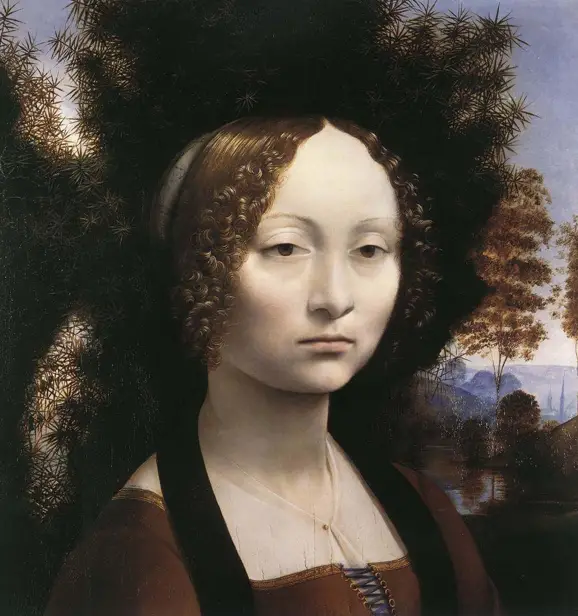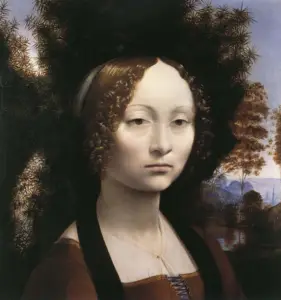Leonardo da Vinci Ginevra de’ Benci
Title: Portrait of Ginevra de’ Benci
Year: c. 1474-1478
Size: 38.1 x 37 cm
Medium: Oil on panel
Location: National Gallery of Art, Washington, D.C.
The Ginevra de’ Benci is a portrait of the 15th-century Florentine aristocrat Ginevra de’ Benci (born around 1458) by Leonardo da Vinci. Ginevra de’ Benci, age 16, or 17, is a babysitter, who is dressed in a brown with blue laces and gold trim, as well as a black scarf. She wears a delicate white shirt with a golden pin beneath the outfit. Her skin is flawless, and her hair is done in ringlets.
Her look is a little irritated on the one hand and proud on the other. Her eyes make this clear. Her left eye is focused on the spectator, but her right eye appears to be staring down at something. Ginevra’s facial expression has been viewed by experts as an indicator that she is unhappy with the (upcoming) marriage. Take note of Ginevra’s sparse brows. Shaving the brows was typical for women at the time, as shown in Leonardo da Vinci’s Mona Lisa.
A juniper bush grows behind Ginevra. The halo of spikes from juniper leaves contrasts wonderfully with Ginevra’s depiction. Mountains, trees, water, a tiny village, and a hazy sky are typical of Leonardo da Vinci’s style in the right background. It is the only Leonardo painting on public display in the Americas, and it is on display at the National Gallery of Art in Washington, D.C.
History of Ginevra de’ Benci
In the leonardo da vinci Ginevra de’ Benci painting, Ginevra de Benci, a well-known young Florentine woman, is largely regarded as a sitter. Leonardo created the picture in Florence between 1474 and 1478, presumably to commemorate Ginevra’s 16th-year marriage to Luigi di Bernardo Niccolini. It is more than likely a commemoration of the engagement.
Contemporary portraits of females were typically commissioned for one of two reasons: betrothal or marriage. Wedding pictures were customarily done in pairs, with the woman on the right facing left and the man on the left; because this portrait faced right, it most likely signifies betrothal.
The juniper bush that surrounds Ginevra’s head and fills much of the background has a purpose other than decoration. The juniper was considered a symbol of female virtue in Renaissance Italy, and the Italian term for juniper, Ginepra, is also a play on Ginevra’s name.
The laurel and palm on the back of the artwork represent Ginepra’s intelligence and moral standards, respectively. However, the laurel and palm were also Bernardo Bembo’s personal insignia, as he was considered to be having a platonic affair with Ginevra. Bernardo Bembo was the Venetian ambassador to Florence, and he most likely commissioned the rear of this painting (as well as the front, according to others, but this is not verified).
Ginevra de’ Benci worth
Unlike Leonardo’s previous female portraits, this lady appears sulky, unforgiving, and arrogant, which is highlighted by the slightly smaller cast of one eye, which makes her appear withdrawn. Her left eye appears to be looking directly at us, while her right appears to be looking beyond some intangible point.
Ginevra, like other Florentine ladies of the time, has shaved her brows (this is also obvious in the Mona Lisa). Perhaps her expression shows that she was not fully enthusiastic about her impending marriage.
Later in life, she would go into self-imposed exile in order to recover from a terrible illness; she was also plagued by an ill-fated love affair.


 Leonardo Bianchi,
the creator of Leonardo da Vinci's Inventions.
Thank you for visiting
Leonardo Bianchi,
the creator of Leonardo da Vinci's Inventions.
Thank you for visiting